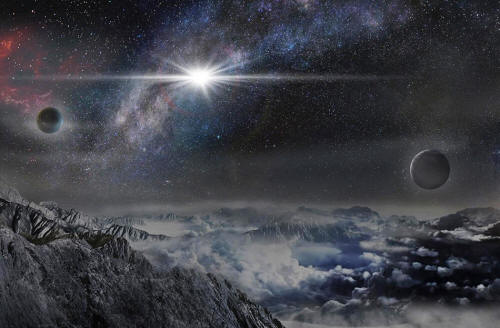|
by The Kavli Foundation
from
Eurekalert
Website
This is an artist's impression of the record-breakingly powerful, superluminous supernova ASASSN-15lh as it would appear from an exoplanet located about
10,000 light years
away in the host galaxy of the supernova.
Record-shattering cosmic blast could help crack the case of
extreme supernova explosions
than a typical supernovae
Stunned astronomers have witnessed a
cosmic explosion about 200 times more powerful than a typical
supernova - events which already rank amongst the mightiest
outbursts in the universe - and more than twice as luminous as the
previous record-holding supernova.
If that statistic does not impress,
consider that this luminosity level is approximately 20 times the
entire output of the 100 billion stars comprising our Milky Way
galaxy.
Given its uncanny brightness and closeness, ASASSN-15lh might offer key clues in unlocking the secrets of this baffling class of celestial detonations.
ASASSN-15lh was first glimpsed in June 2015 by twin telescopes with 14-centimeter diameter lenses in Cerro Tololo, Chile conducting the All Sky Automated Survey for SuperNovae (ASAS-SN), an international collaboration headquartered at The Ohio State University. (Hence ASASSN-15lh's somewhat menacing moniker.)
These two tiny telescopes sweep the skies to detect suddenly appearing objects like ASASSN-15lh that are intrinsically very bright, but are too far away for human observers to notice.
Subo Dong and colleagues immediately put out word about the sighting of ASASSN-15lh in order for as much data as possible to be gathered.
Multiple, far larger ground-based
telescopes across the globe, as well as NASA's Swift satellite, have
since taken part in an intense observing campaign that continues to
this day.
By examining this bright, slowly fading
afterglow, astronomers have gleaned a few basic clues about the
origin of ASASSN-15lh.
This spectrum puzzled the ASAS-SN team
members, for it did not resemble any of spectra from the 200 or so
supernovae the project had discovered to date.
Dong found a close spectral match for ASASSN-15lh in a 2010 superluminous supernova, and if they were indeed of a kind, then ASASSN-15lh's distance would be confirmable with additional observations.
Nearly 10 days passed as three other telescopes, stymied by bad weather and instrument mishaps, attempted to gather these necessary spectra.
Finally, the 10-meter South African Large Telescope (SALT) secured the observations of elemental signatures verifying ASASSN-15lh's distance and extreme potency.
The ongoing observations have further revealed that ASASSN-15lh bears certain features consistent with "hydrogen-poor" (Type I) superluminous supernovae, which are one of the two main types of these epic explosions so named for lacking signatures of the chemical element hydrogen in their spectra.
ASASSN-15lh has likewise shown a rate of
temperature decrease and radius expansion similar to some previously
discovered Type I superluminous supernova.
Type I superluminous supernova seen to
date have all burst forth in dim galaxies both smaller in size and
that churn out stars much faster than the Milky Way.
Exceptionally, however, ASASSN-15lh's galaxy appears even bigger and brighter than the Milky Way.
On the other hand, ASASSN-15lh might in
fact reside in an as-yet-unseen, small, faint neighboring galaxy of
its presumed, large galactic home.
With Hubble, Dong and colleagues will
obtain the most detailed views yet of the aftermath of ASASSN-15lh's
stunning explosion. Important insights into the true wellspring of
its power should then come to light.
But ASASSN-15lh is so potent that this compelling magnetar scenario just falls short of the required energies.
Instead, ASASSN-15lh-esque supernovae might be triggered by the demise of incredibly massive stars that go beyond the top tier of masses most astronomers would speculate are even attainable.
|


